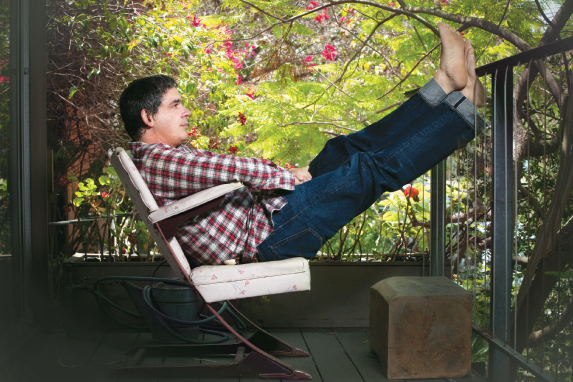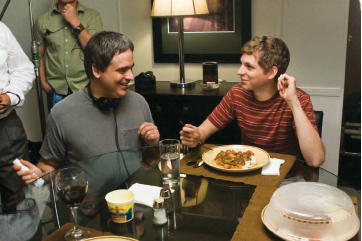BY MARGY ROCHLIN
 FREESTYLE: Miguel Arteta has made a name for himself by turning out low-budget,
FREESTYLE: Miguel Arteta has made a name for himself by turning out low-budget,
character driven, sad comedies that elicit queasy laughs. (Credit: Brian Davis)
Miguel Arteta was 26 and playing poker with a group of buddies at their rented Los Angeles canyon home, heavily decorated with World War II movie props, when he realized that their landlord was one of his directing heroes, Sam Fuller. Not much later, during one of Fuller's visits, Arteta found himself sitting across from the iconoclastic filmmaker, being given an impromptu two-hour cinema lecture for an audience of one, much of which focused on the importance of trusting one's instincts.
"He stood up and his cigar was right in my face and said, 'Listen to me: Cast on hunch. Cast your neighbor, cast the biggest movie star in the world, I don't care. Just cast on hunch,'" says Arteta, whose filmography at the time included a single entry: a short, musical satire about the self-help movement called Every Day is a Beautiful Day. "He said, 'People are going to tell you a million things about who you should cast. Cast on hunch.'"
Since then, Arteta has made a name for himself by turning out low-budget, character-driven, sad comedies that elicit queasy laughs and have a tendency to feature droopy outsiders as the lead protagonists. In each of them—Star Maps, The Good Girl, Chuck & Buck and, most recently, Youth in Revolt—you can practically hear Fuller's barking refrain.
For Chuck & Buck, Arteta used filmmaker brothers Chris and Paul Weitz, as well as Latina character actress Lupe Ontiveros, at the center of a story about a pale, Blow Pop-sucking, 27-year-old boy-man (Mike White). When he tapped Jennifer Aniston to play a doleful small-town store clerk in The Good Girl, the mention of her name only conjured up the effervescent Rachel Green on Friends. "I think it's important to have a bold, intuitive piece of casting in every movie because it sort of personalizes the film for the audience," explains Arteta, who hired improvisational whiz Fred Willard (Best in Show) for Youth in Revolt to play the role of an aging radical. "He has, like, three lines. His character spends most of the time laying face down on the carpet, tripping his brains out, and yet he's still a very strong presence."
While part of the critical success of Arteta's films stems from his oddball casting choices, the Puerto Rico-born 44-year-old still faces the same struggles as anyone in Hollywood—especially the kind that involve executives who are less than interested in finding the perfect actor for a role. "When you're in studio meetings, everybody is an expert in casting and everybody talks to you about it. They really try to give you a million reasons why you should cast a person. They say, 'We're not telling you to cast the movie wrong. Just get a really, really famous person who is right!' They have intellectual reasons, like, 'Oh, he's a much colder person, or warm,' and you can discuss it to death," says Arteta, who has come to regard such debates as a reminder that no one knows better than he does about the kind of movie he envisions making. "As a director, you're being actively combated not to listen to your hunches, so it's actually extremely helpful."
For a lover of creative collaboration like Arteta, it's essential that once production begins he is surrounded by a reliable support team, often including White, who wrote and acted in Arteta's most quirky and weirdly touching films, The Good Girl and Chuck & Buck. Chuy Chávez has served as director of photography on nearly all of Arteta's movies. Before 1993, Arteta had never heard of Chávez, who is a celebrated cinematographer in Mexico. Then he saw El bulto, a retelling of Rip Van Winkle by Mexican director Gabriel Retes. "There was something about the way [Chávez] held the close-ups of people's faces that I just loved," says Arteta. "It's a certain kind of thing that has to do with the framing and the lighting that just creates a feeling. Chuy treats actors with such respect and love and essential humor."
 HORSING AROUND: Michael Cera (right) plays one of Arteta's typical
HORSING AROUND: Michael Cera (right) plays one of Arteta's typical
bumbling misfits in Youth in Revolt. But for once in an Arteta film, it
has a nearly-happy ending. (Credit: Dimension Films/Bruce Birmelin 2009)Arteta somehow managed to convince Chávez to shoot his directorial debut, Star Maps, even though the film was made in 29 days for less than $500,000. What this meant was that Chávez, who had just won the Mexican equivalent of the Academy Award, slept on a mattress in the basement of Arteta's house, was forced to use a skateboard as his camera dolly and had virtually no crew. "I told Chuy, 'I have two guys who just got out of college who smoke a lot of pot,' and he was like, 'Two guys? For the camera department?' And I said, 'No, no, no. Two guys. For everything.'"
Chávez also had to fill in as a sort of mentor to Arteta, a recent graduate of AFI who was short on practical moviemaking experience and was far too concerned with things like a perfectly arranged shot list. "I remember doing a scene where I had the actors get in front of the camera and say the lines and I was immediately worrying about where to put the camera and Chuy told me, 'Listen, make me believe what they're doing and then don't worry. The camera thing will sort itself out.' And I realized, 'Whoa, this guy is teaching me what the job is.'"
One of Chávez's lessons? Working with what you have. Though Chávez shot Chuck & Buck in digital video on a three-chip camera, the critics embraced the unpolished look of the final print as part of the film's aesthetic ("an engagingly slapdash quality" is how one reviewer characterized it). "The camera was so terrible that our only hope and prayer was to make it look like a blown-up 16 millimeter print, so we transferred it to 35, then retransferred it to video," says Arteta.
Arteta's dryly funny, almost monotonal films are dialogue-filled and totally absent of classic action sequences. An actor who ends up in one of them had better not mind ever seeing dailies. "Then they don't get self-conscious and start thinking about [their performance] too much," he says. His actors must also enjoy emoting in close-up. "Sometimes I slam a camera right in their faces and it can be very uncomfortable," admits Arteta, who has a short speech he delivers to cast members thrown off-balance by his claustrophobic shooting style. "I tell them that I want to create an intimacy with the audience, a role for the audience to play when they're watching the story come out."
Another hallmark of an Arteta film is that they're filled with bumbling misfits who are usually oblivious to the fact that those around them find their behavior jaw-droppingly inappropriate. He has a pep talk for the actors about how to pull that off, too. "I tell them, 'If you don't feel like you're jumping into an empty pool chest-first, then we have a problem.' It has to feel that crazy and uncomfortable."
Arteta's latest film, Youth in Revolt, based on the darkly humorous novel by C.D. Payne, is a coming of age tale about a teenage boy (Michael Cera) obsessed with losing his virginity. It was shot in HD digital video in roughly 40 days—a luxurious schedule by Arteta's fast-paced indie standards. Overflowing with cringe-inducing humiliations, emotional desperation and comically idiotic authority figures, Youth in Revolt still manages to be a different sort of film for Arteta. There are animated segments, a chain reaction explosion scene and a near-happy ending—all firsts for the director—yet there's no mistaking who made the film.
Having a cinematic voice, says Arteta, is something he learned studying movies made in the Hollywood studio system. "The amazing thing about directors in the golden age is that they were contract players who were assigned scripts and told, 'You've got to make something that's glossy and entertaining.' The good ones, like John Ford, Frank Capra, Nicholas Ray, by sheer personality and strong point of view, made their worldview come through. When you watch those movies, you start to realize that trying to imitate anybody is a waste of time. I think a lot of kids nowadays don't get that. Your biggest weapon is the way you see the world."